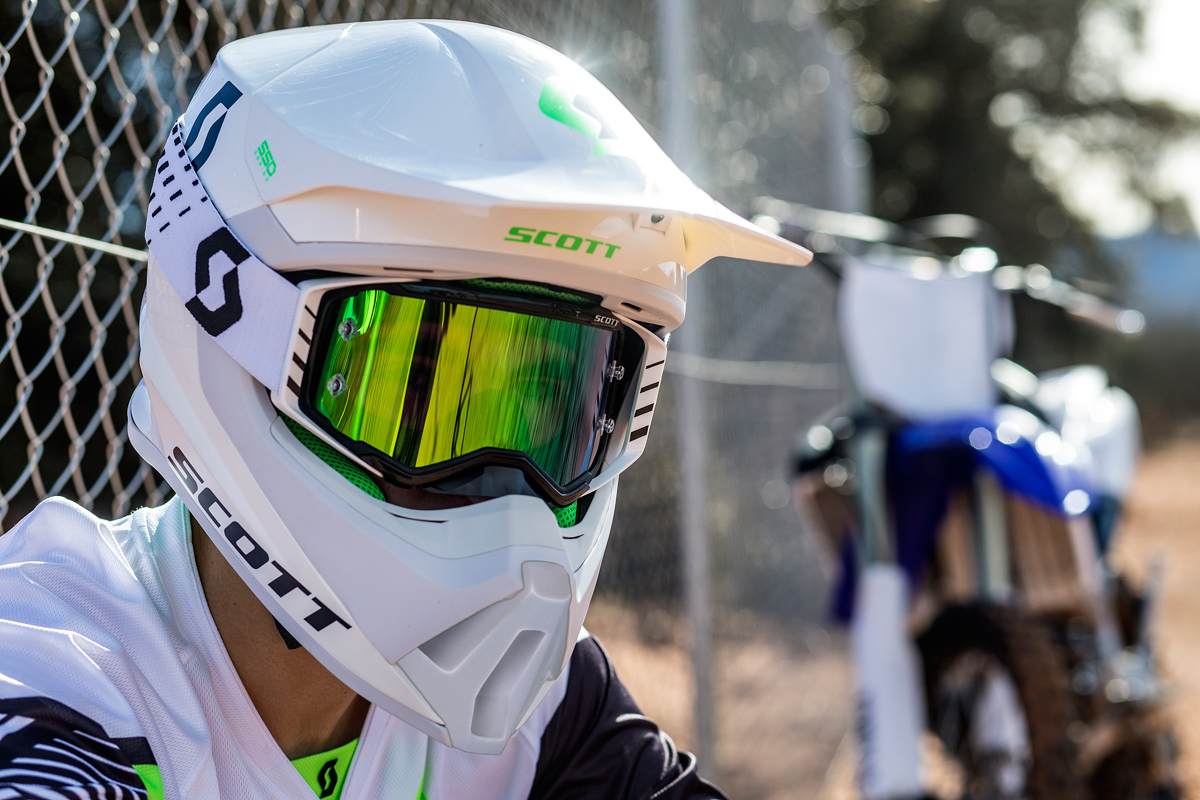Scott Sports have previously been a ‘head-to-toe’ brand for off-road motorcyclists but it is not harsh to speculate that their excellent goggles and curious experiments with boots were the main catchpoints for many riders. Body protection was another strong area and their riding gear was also of quality, even if it did lack some of the design sharpness compared to brands like Fox, Alpinestars and Answer. Their efforts with helmets were well intentioned but fairly uninspiring.
After pushing out a 550 riding boot that boasted a ‘tulip’ construction and featured a couple of other interesting specs and the innovative Prospect goggle, Scott have now finalised four years of research and graft into the new 550 helmet. And for good reason the firm are getting shouty about what they have achieved for a price point just over 250 euros.
“When Scott develops a product then we are usually looking at the market a lot and what kind of innovation we can bring,” says Export Sales Manager Matt Lalloz. “We could see that this [helmet] market remains really conservative and there are always ways for improvement. We have made mistakes in the past but at least we were bringing ideas and I think this 550 is something that is really reaching the next step. For sure people will need to understand it because Scott is not seen as a helmet brand so they will need to see what is behind the concept.”
“This is the first helmet we have made in-house for motorcycles,” says Helmet Product Manager Paul Batsch. “Before we had an open-mould from the factory and that’s what many brands do…but our goal was to have a real ‘homemade’ project.”

Flow
Safety, ventilation, identity and cost are the four watchwords for the 550. The need to sculpt a helmet that serves a purpose for the rider in everyday function as well as performing in the event of a crash was key for the design team and they channelled that focus into their ‘channels’.
“We looked at ‘benchmark’ helmets for enduro and motocross and what many people were using,” says Lead Engineer Anatole Deheselle. “We took those helmets and looked at what was happening inside and in terms of ventilation. We found a lot of tiny holes and channels. We took our knowledge from bicycle and winter helmets to make our own improvements and ideas.”
“What we did is make super-deep channels inside to drive the air into the helmet. We have a big air intake in the front to bring as much air as possible. You have a lot of circulation flow for hot conditions. This was a big focus. We could make our own mould and we did the design in sketches, in 2D and 3D to make sure it worked and then went to a lab in Milan with a wind tunnel where we could really test the helmet in riding conditions. We used ours against some of the bestsellers and simulated a 40 minute ride at 60kmph average speed and thanks to a headform with a lot of sensors we could create a map against the others.”
“I remember using helmets in the past that had holes for ventilation and I never actually felt that effect,” reflects former Pro racer and Supercrossers Lalloz. “I think it is a good question for many riders: do you really feel ventilation in your helmet? I’m 99% sure that the majority will say no. Why? Because most of the holes and channels will be the same as a road helmet where you can be doing 100-200kmph, whereas in motocross it will be between 45-55. It is a low average and we analysed this from the beginning.”

“We compared many competitors – some leading brands – at 45kmph and this was the key in the development of our own product,” he adds. “It was not easy because you also need to follow the certification guidelines and cannot put massive holes everywhere. It was a big job and several years of development. It is also an exclusive Scott product designed by Scott engineers with some knowledge from bicycles in there as well.”
“We tried to take a different approach based on our own knowledge and took it all the way,” affirms Batsch.
Scott have achieved an airy helmet – see the image from the wind tunnel tests with a larger blue ‘cool’ spread around the head – but they also needed to add versatility. Not everyone rides in Californian sunshine. To cater for this the helmet comes with different densities of foam inserts that can be slotted into the ducts for winter or sandy/dusty conditions. The extent of the airflow also was considered with the goggle fitting.
“Everything was tested with a goggle for real riding conditions and goggles are getting bigger and bigger which means the gap between the top of the goggle and the helmet is getting smaller,” says Batsch. “This means less air coming into the goggle and more risk of fog. The channels on our helmet really help to keep the circulation of air into and out of the goggle as well. There is obviously a smart connection with the Prospect goggle, and the temperature inside was lower compared to other helmets.”
Working technology
Helmets now offer more than just a hard shell and a dual density EPS. Regular readers of OTOR will have seen the efforts of companies like 6D, Leatt, MIPS and lately Bell and now Shoei in creating advanced methods tackling rotational acceleration and concussion thresholds. Scott knew that a new helmet offering had to have extra technical considerations. Therefore the 550 comes with MIPS and a ‘Conehead’ liner configuration as part of the architecture and the use of a polycarbonate shell to keep costs in check.
To read the rest of the article simply click HERE
Photos by Scott Sports








